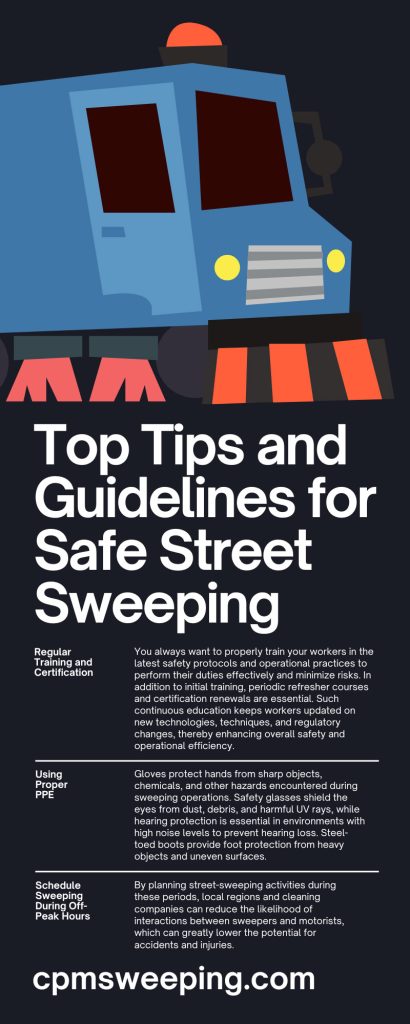Street sweeping is an essential service that helps both small towns and big cities maintain clean, safe, and attractive urban environments. Here are some of the top tips for guidelines for safe street sweeping to make the job go more smoothly.
Regular Training and Certification
Ensuring that street-sweeping personnel receive regular training and certification is crucial for maintaining high safety standards. Training programs should cover various aspects of street-sweeping operations, including the proper handling of equipment, hazard identification, and emergency response procedures.
You always want to properly train your workers in the latest safety protocols and operational practices to perform their duties effectively and minimize risks. In addition to initial training, periodic refresher courses and certification renewals are essential. Such continuous education keeps workers updated on new technologies, techniques, and regulatory changes, thereby enhancing overall safety and operational efficiency.
Using Proper PPE
Personal protective equipment (PPE) is a critical component in ensuring the safety of street-sweeping personnel. Proper PPE includes items such as high-visibility clothing, gloves, safety glasses, hearing protection, and steel-toed boots. High-visibility clothing ensures that motorists can easily see workers, especially in low-light conditions or areas with high traffic.
Gloves protect hands from sharp objects, chemicals, and other hazards encountered during sweeping operations. Safety glasses shield the eyes from dust, debris, and harmful UV rays, while hearing protection is essential in environments with high noise levels to prevent hearing loss. Steel-toed boots provide foot protection from heavy objects and uneven surfaces.
Ensuring that all workers have and consistently use the appropriate PPE is fundamental to preventing injuries and maintaining a safe work environment. You should also conduct regular inspections and replacements of PPE to ensure that the equipment remains in good condition and continues to provide effective protection.
Schedule Sweeping During Off-Peak Hours
A helpful tip and guideline for safe street sweeping involves scheduling your operations during off-peak hours. This can help in minimizing the risk of accidents and ensuring the efficiency of the cleaning process. Off-peak hours typically refer to times when traffic volume is low, such as late at night or early in the morning.
By planning street-sweeping activities during these periods, local regions and cleaning companies can reduce the likelihood of interactions between sweepers and motorists, which can greatly lower the potential for accidents and injuries.
Furthermore, conducting street sweeping during off-peak times allows for a more thorough cleaning, as there are fewer parked cars and obstructions on the roads. This results in a more comprehensive and effective cleaning operation, which enhances the aesthetics of urban environments. Also, reduced traffic congestion during sweeping operations can decrease fuel consumption and emissions from sweepers, contributing to a greener and more sustainable environment.
To implement this strategy effectively, you need to communicate the schedule to the public in advance. For example, many areas will have clear signage warning cars not to park in certain areas at times when the street sweepers will be more active.
Maintain Your Equipment
If you want to keep your street sweepers in good condition and make the whole process safer for those operating the equipment, you need to keep them in good condition. Regular maintenance checks and service prevent equipment failures that could lead to accidents or operational downtime. A thorough maintenance program should include daily inspections, periodic servicing, and prompt repairs of any identified issues.
In addition to regular checks, you should periodically service your machines with a qualified technician. These service procedures can include changing oil, lubricating moving parts, and replacing worn-out components. Keeping detailed maintenance records for each piece of equipment is crucial for tracking service history and scheduling future maintenance activities.
By maintaining the street-sweeping equipment diligently, municipalities and cleaning companies can enhance the safety and efficiency of their operations, prolong the life of their machinery, and avoid costly breakdowns.
Conduct Pre-Operation Inspections
Conducting thorough pre-operation inspections is a critical step in ensuring the safety of street-sweeping activities. Before commencing their shifts, operators should systematically inspect their equipment to identify and address any potential issues that could compromise safety or operational performance.
The pre-operation inspection should start with a visual check of the vehicle’s exterior, ensuring that lights, mirrors, and warning signals are functioning correctly. Operators should also inspect the tires for proper inflation and any signs of damage or wear. It’s also a good idea to look at the engine and check things like oil, coolant, and hydraulic fluids to ensure that they’re within the recommended ranges. Operators must also test all control panels and switches to confirm they are operational.
Beyond the basic vehicle inspection, it may also be a good idea to pay close attention to the street-sweeping components. Check the brushes for wear and double-check that they’re free of debris that could hinder performance. Make sure there aren’t any clogs in the water spray systems and that they’re delivering water at the right pressure. Lastly, be sure to examine any hoses and belts for signs of cracking or fraying.
Enhance Communication and Coordination
Effective communication and coordination are fundamental to the success and safety of street-sweeping operations. Establishing clear lines of communication among team members, supervisors, and other stakeholders ensures that everyone knows their roles, responsibilities, and the overall schedule. This both enhances operational efficiency and helps in promptly addressing any issues that may arise during street-sweeping activities.
Implementing a reliable communication system is the first step. Equip all personnel with radios or mobile communication devices to facilitate instant and clear communication. This allows operators to report hazards, equipment malfunctions, or other emergencies immediately, enabling quick response and resolution. Regular team meetings before and after shifts can also provide a platform for discussing schedules, addressing concerns, and sharing important updates.
By following these top tips and guidelines, you can ensure a safer and more efficient street-sweeping operation. For professional and reliable street-sweeping services, look no further than CPM Sweeping. We are committed to maintaining clean and safe streets with our experienced team and state-of-the-art equipment. Contact us today to learn more about how our street-sweeping services can benefit your community.


